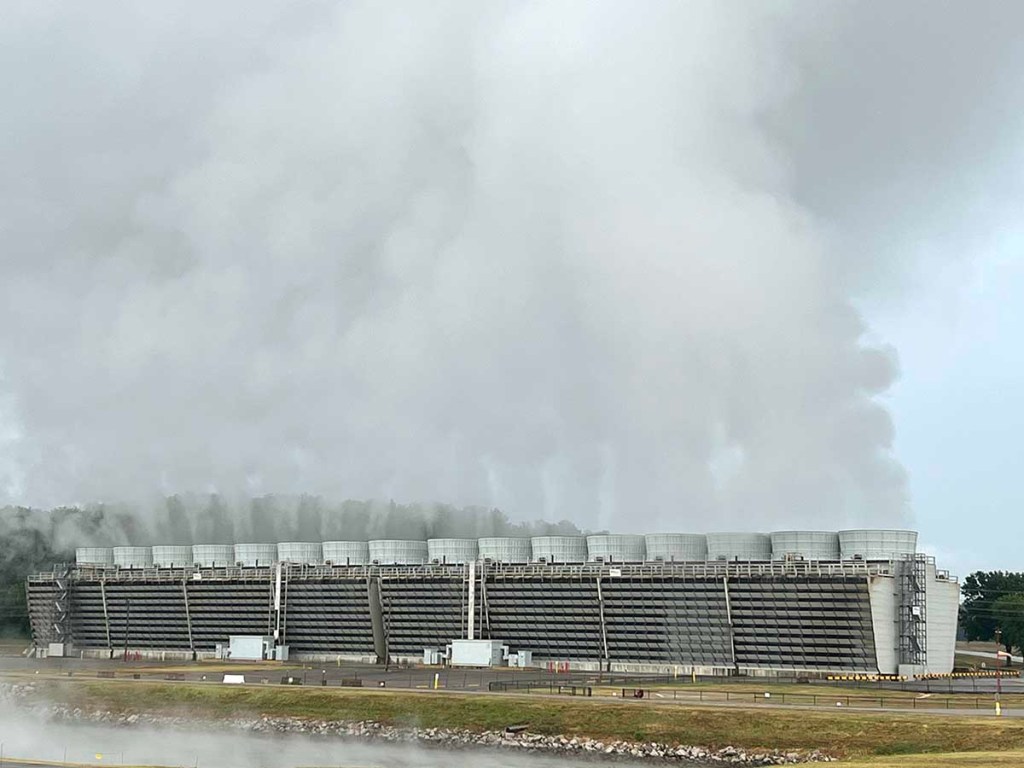Browns Ferry on track to mark record power consumption
Published 12:00 am Thursday, August 1, 2024

- Several cooling towers are in operation July 19, 2024, at Browns Ferry Nuclear Plant near Athens.
Last week set the record for the hottest days globally that humans have measured, with more record-breaking heat likely ahead, reported the European climate service Copernicus, July 23.
And as Mother Nature continues to turn up the heat in August, the assistant maintenance director at TVA’s Browns Ferry Nuclear Plant continues to monitor with anticipation the mercury rising: A little more than a week ago, prompted by millions of homes and businesses engaging with their air conditioners, the plant was on track to mark a record power consumption of more than 3,100 MW.
“And then it rained,” said Wally Miller, the assistant director tasked July 19 with explaining to a group of journalists how the Tennessee Valley Authority is planning not only for a record-setting amount of electricity usage, but for a continuing population explosion of new homes and businesses in North Alabama. That footprint includes Limestone — the fastest growing county in the state.
While recent rains may have tamped temperatures and thermostats for the short term, Miller said, TVA is forecasting and building to keep the lights on for both a growing population and an increasingly electrically driven climate, including one that will support the hundreds of thousands of electric vehicles the authority anticipates will be driving Alabama’s highways in just a few years.
Preparations
In many ways, large and small, TVA is prepping now for those conditions, Miller said, including completing more than 75 projects across the system this spring and a few things specific to Browns Ferry, such as cooling towers upgrades to enhance power reliability.
So far, the power authority has had things in hand. Browns Ferry itself can produce 3,954 MW of electricity today — enough to power 2 million homes and businesses in the Tennessee Valley — meaning that, even with near-record breaking usage, “We are not even beginning to bump against our reserves,” Miller said.
And more, he said, TVA and the plant are doing so with as clean an energy production as possible.
Carbon free energy
“The thing about our system is that we are a mix of wind, solar, gas, hydro, coal and nuclear,” he said. and with nuclear producing about 40-42 percent of that mix, the system (is about) 58 percent carbon free, said Miller, with a goal of “working to be net zero by 2050.”
But meeting a net zero carbon emission goal and increased needs won’t come without hurdles, the largest of which is supplying power for a rapidly growing region, the director said.
“The biggest challenge we’re seeing right now is population growth, business growth,” Miller said. “Our region is growing three times faster than the national average. The University of Tennessee did a study earlier this year that projects we will grow 22 percent population by 2050. Last year, GDP in our region grew 0.4 percent faster (2.9 percent) than the national average (2.5 percent).”
Building for EVs and more
Seasonal hurdles, in terms of cooling homes and businesses, and maintaining a less than 10 degree temperature deviation of the Tennessee River at the point of the plant’s water output, present immediate tests, the director said: “Summer is a big challenge for us.”
But another challenge the TVA is planning for is a marked increase in the number of electric vehicles — and their private and public charging stations — registered in the state.
“Our goal is to have 200,000 electric vehicles in our region by 2028,” Miller said. “And even if we turned all of those on this afternoon — if they magically appeared — it would be a 1/2 percent on our load. … and most of the charging of those are in the down period, at the night time, when the system isn’t getting as stressed. (Basically, he said,) it’s the equivalent of having a clothes dryer in your home. You’re just putting in another outlet.”
But meeting such an electricity need — the 200,000 goal would be a significant increase in EVs on the road compared to the fewer than 20,000 registered in Alabama today — also means having the infrastructure to provide it, something that Miller said TVA is working on.
“That’s why we’re putting in the charging stations — to get us to that goal.” Miller said. “Originally, it was the chicken and the egg. Do I put the cars out and no charging? Or put out the charging (stations). We said we’ll do the infrastructure and that will take the chicken and egg argument out of it. We’ve got those (stations) every 25 miles across major highways and freeways, including two in downtown Huntsville and the one in Cullman. The Cullman one is important because if you’re going to the beach or Nashville, it’s one stop and then you go all the way down or back.”
Ready for the season, and beyond
Keeping those vehicles going down and back, and ambient inside temperatures cooled for human consumptions are and will be the ultimate goals in the summer, Miller said. For the nuclear plant and TVA, that means “completing seasonal readiness reviews and actions to ensure generation assets are prepared to meet the weather conditions.”
And in preparing for the future, Miller said that, “TVA is building more than 3,800 MW of new generation (power) including solar, energy storage, combustion turbines and combined-cycle natural gas.”
How electric users can help
But the ultimate goal? All of the maintenance, upgrades and day-to-day operations are being done with the intention of inspiring trust, Miller said.
“We just want everyone to have the confidence that we’re putting the time and effort into whatever is needed to ensure to providing (that the) power doesn’t go out,” Miller said.
“We’re constantly maintaining things, constantly upgrading things to make sure we’ll meet those demands,” he said, while noting that individuals can assist in that surety.
“Shut the blinds, put the thermometer up, cook outside on the grill (during heat waves) — that’ll help with that,” he said.





